Types of plum trees: 12 varieties to grow for a fruitful autumn harvest
We've rounded up some of the best types of plum trees for a bumper crop of delicious fruit
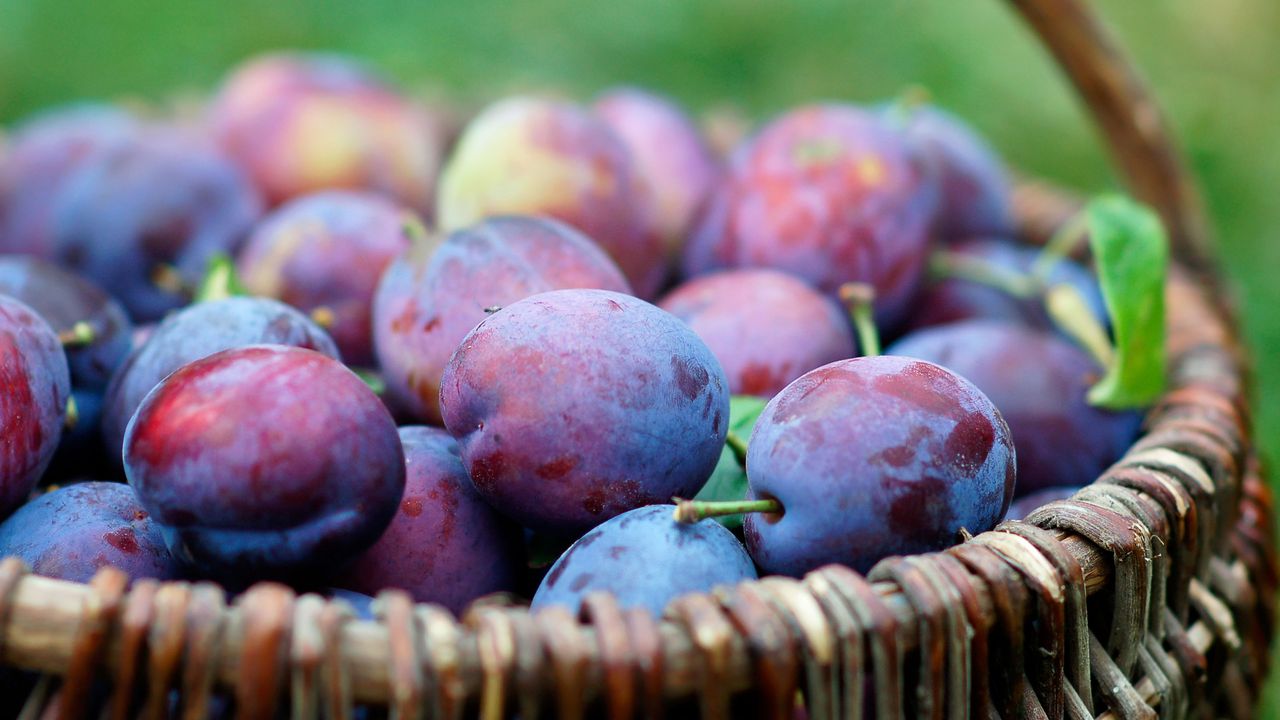

If you want your best ever autumn harvest, get to know the various types of plum trees to grow in your garden. You can't beat them for a delicious late summer sweet treat, and once they get going, they're super producers.
Laden baskets of ripe fruit are the dream if you're keen on growing your own produce. Learn how to grow plums, and you'll be rewarded with exactly that, whether you like them picked fresh from the tree or prefer to use them in delicious cakes and crumbles. Damsons, a smaller fruit with dark blue skin that's often juicy, but tends not to be eaten raw as they can be a little tart, are also part of the family. And greengages, a small fruit with greenish-yellow skin and flesh and a sweet, honeyed flavor, are too.
When choosing a plum tree to grow in your garden, you'll want to know which are best for eating and which are better if you want to use them for cooking. We've chosen the best types of plum trees to grow that tick all the boxes, from older varieties to newer ones, so you can narrow down your selection.
12 types of plum trees to grow in your garden
If you want to grow plums, greengages and damsons, here are some of the most reliable, prolific and tastiest varieties to try in your potager garden.
1. Plum 'The Czar'
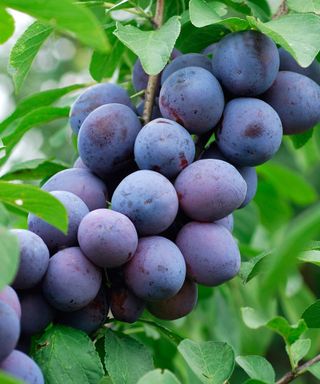
Plum 'The Czar' does well in cooler climates
Compact, hardy and an excellent early season variety for preserves, this fine blue plum cooks down to a luscious ruby red. It's highly ornamental in spring, when it's loaded with white blossom.
This plum is named in honor of the Czar of Russia, who visited the UK in 1874, the year it first appeared. It can be grown in a range of soils, does well in cooler climates, and the flowers have some resistance to frosts.
You can harvest the fruits from early August. The tree will grow to an eventual height of up to 4 meters (around 13.1ft).
- You can find more of the best trees for small gardens in our expert guide.
2. Plum 'Coe's Golden Drop'
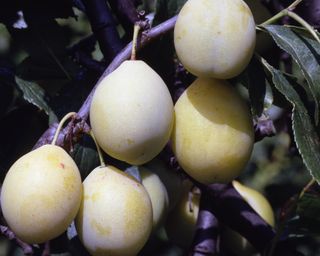
A traditional variety with golden fruit
Considered one of the tastiest English plums to grow, this traditional golden fruiter can be eaten fresh and used for cooking.
It has a soft, rich flavor reminiscent of a greengage, plus the distinctive tangy sharpness of more vibrant plum breeds. This intriguing blend probably has something to do with its origins, being produced from a gage pollinated by an old French plum called 'White Magnum Bonum'.
It should be ready to harvest from mid-autumn, and reaches heights of up to 4 meters (approximately 13.1ft).
3. Plum 'Mirabelle de Nancy'
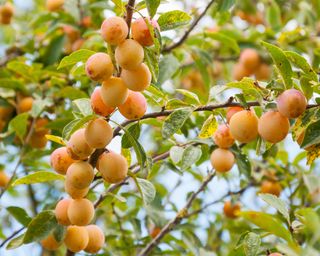
Pretty Mirabelle plums look a lot like oversized cherries
These pretty pink and gold fruits, known as cherry plums, look a lot like oversized cherries. Also known as Mirabelle prunes, these delectable European heirloom plums are heavy cropping and deliver a high sugar content so they're delightful in jams, jellies and brandies. But, they can also be enjoyed fresh from the tree, which will grow up to 4 meters (13.1ft) in your garden.
Other Mirabelles include 'Plum de Metz', 'Golden Sphere' and 'Ruby'. Harvest the fruit from late July.
Want to grow real cherries in your garden, too? Our guide on how to grow cherries will help you get started.
4. Damson 'Farleigh'
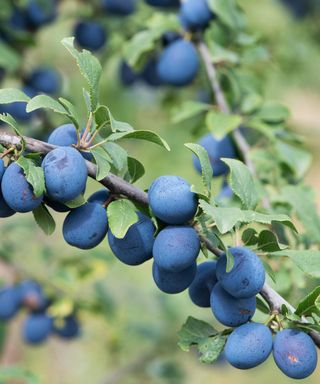
Damson 'Farleigh' is an old favorite that dates back to the early 1800s
This hardy damson (also known as 'Farleigh Prolific') dates back to the early 1800s, and has a reputation for being a fabulously prolific cropper.
A popular choice for jams, pies and wines, these fruits are almost black in color. What's more, 'Farleigh' damsons are very resistant to silver leaf disease.
It's recommended to invest in one with a 'St Julien A' rootstock to guarantee the best returns. Harvest the fruit from mid-September. The tree will grow up to around 4 meters (13.1ft).
Unsure of the difference between greengages, plums and damsons? Our feature explains all.
5. Damson 'Prune Damson'
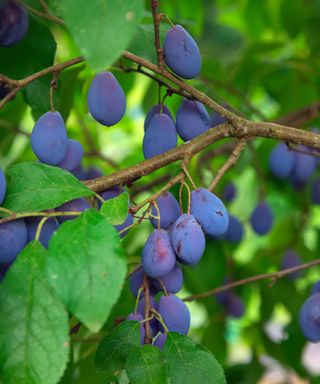
Damson 'Prune Damson' is a vigorous Old English variety
Also known as 'Shropshire Damson' or 'Shropshire Prune', this luminescent purple beauty is vigorous and neat growing.
Deliciously intense as a jelly or jam or dried for prunes and also amazing in savory dishes, this old English variety (which dates back to the 1670s) is unfussy and manages well in damp soils and cooler climates.
The trees, which grow up to around 4 meters (13.1ft) also produce pretty spring blossoms, so they're one to consider if you're looking for some of the best flowering trees to add to your plot. You can harvest the fruit from September.
6. Greengage 'Oullins Golden Gage'
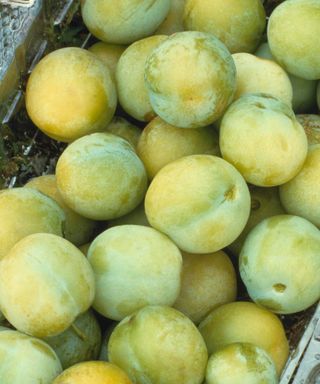
'Oullins Golden Gage' can adapt to cooler climates better than most gages
Fragrant, large and pleasantly plump, this golden greengage dates back to the mid-1800s in Lyons and is widely known as an excellent choice for the fruit tree aficionado.
While gages tend to need more warmth than damsons to attain the desired levels of sweetness, this gage can adapt to cooler climates. The fruits, ready from mid-August, are ideal for both dessert and culinary uses. They may be less juicy than some, but this makes them better for freezing.
The trees' eventual height can be up to 4.5 meters (14.8ft).
7. Greengage 'Reine Claude Verte'
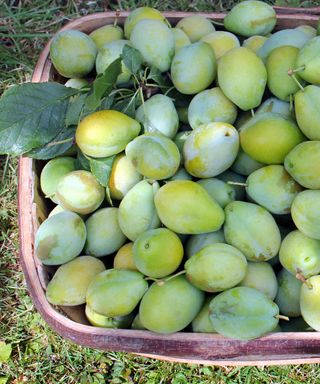
Greengage 'Reine Claude Verte' is a vigorous grower with a rich flavor
Heavy-cropping, reliable and divinely juicy, this old-fashioned sweetie is a vigorous grower. Potent and aromatic, this particular French specialty is lovely eaten fresh or cooked up in pies and jams, and has a sublime depth of flavor.
Known for its distinctively greeny-golden hue and oval shape, this fully hardy greengage will tolerate most soils except very chalky ones.
Harvest the fruit from mid-August or early September. The trees are a little taller than some other types, reaching an eventual height of up to 5 meters (16.4ft).
- If you want to add to your fruit crops, how about learning how to grow figs, too?
8. Plum 'Victoria'
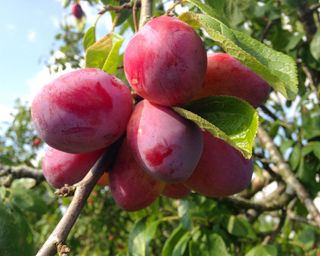
Plum 'Victoria' is an old English favorite
One of the best-known types of plum trees, this popular variety has heavy, regular crops. The pink, medium-sized fruits are ready in late summer. This variety is self-fertile and does not require a pollination partner.
If you want to cook with them, they're good for making jam and pies, and they're also nice to eat straight from the tree in late August. They reach an ultimate height of up to 4.5 meters (14.8ft).
9. Plum 'Laxton's Delight'
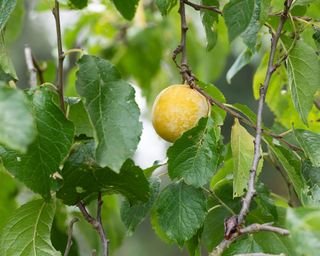
A late summer treat
This dessert plum has a delicious flavor and the plentiful, large, yellow fruits are ready to eat in late summer.
It is partially self-fertile, so will set some fruit by itself. Having another same or different plum variety with the same or adjacent pollination group nearby will help with cropping.
This variety grows to 2.5-4 meters tall (8.2–13.1ft). Keep it in top condition by learning how to prune a plum tree – our guide is full of useful tips.
10. Plum 'Avalon'
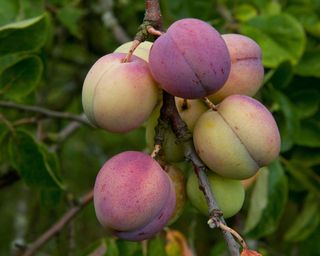
A delicious dessert plum
A newer variety, 'Avalon' is one of the finest dessert plums, producing large, oval-shaped, golden-red flushed fruits. Moderately juicy, fairly sweet and with a good flavor, these are best eaten straight from the tree.
The fruits also make a delicious jam and bake well into puddings when they're slightly under-ripe. What's more, 'Avalon' is a strong growing tree with beautiful clusters of white blossoms during spring. It grows to an eventual height of 2.5–4 meters (8.2–13.1ft).
11. Plum 'Pershore'
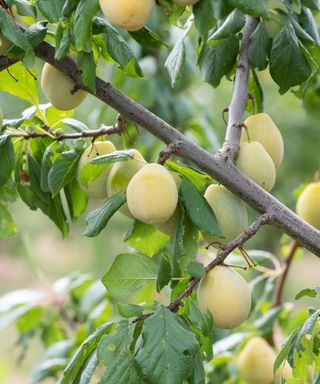
The perfect choice if you're new to growing plums
'Pershore', also known as the 'Yellow Egg Plum', is one of the best types of plum trees to grow if you're looking for a traditional, old-fashioned cooking variety. The heavy and reliable crops of large fruits have a sweet and delicious flavor.
Perfect for cooking in desserts as well as an ideal plum for bottling, they're also tasty when fully ripe and picked and eaten straight from the tree.
An easy grower, it has good disease resistance and is very hardy, which makes it an ideal choice for beginners. It grows to an eventual height of between 2.5–4 meters (8.2–13.1ft).
Our round-up of easiest vegetables to grow has more top picks if you'd like to expand your garden's harvest for minimum effort.
12. Plum 'Opal'
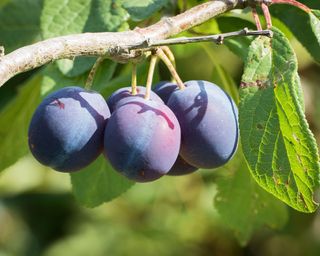
This variety produces an excellent crop
This dessert variety is one of the best types of plum trees to try as it's so reliable. It's very hardy and produces heavy crops on trees that grow vigorously. For best results grow with another variety.
The small, purple fruits have a good flavor and are ready to harvest in late summer. The golden flesh easily separates from the stone, which means it's ideal for cooking too. The trees reach an ultimate height of up to 4.5 meters (14.8ft).
Where to buy plum trees
Although you can buy plum trees in garden centers, you can also order them online. Use our quicklinks below to start shopping for your chosen varieties.
Where to buy plum trees in the UK:
- Shop plum trees at Amazon
- Shop plum trees at Crocus
- Shop plum trees at Dobies
- Shop plum trees at Primrose
- Shop plum trees at Suttons
- Shop plum trees at Thompson & Morgan
- Shop plum trees at You Garden
Where to buy plum trees in the US:

As assistant editor of Amateur Gardening magazine, Janey's gardening passion was fostered from an early age, when her amazing mum had her deadheading hydrangeas, mulching roses, and propagating strawberry plants from runners for school open days. She's also taken part in lots of conservation and rewilding projects for the RHS and TCV as a way of exploring her horticultural horizons.
